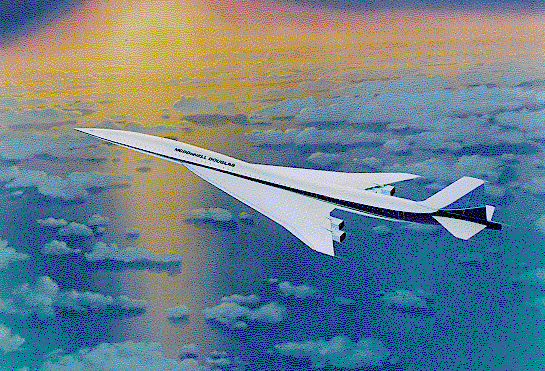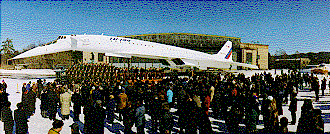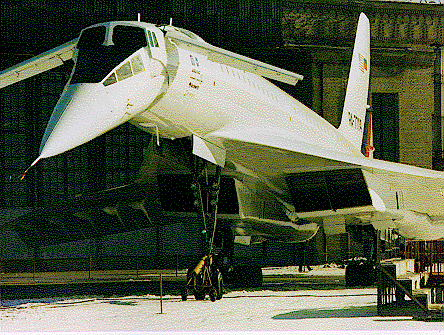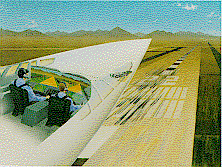 |
|||||
| Home | Research | For Teachers | HISTORY Level 1 Level 2 Level 3 |
PRINCIPLES Level 1 Level 2 Level 3 |
CAREER Level 1 Level 2 Level 3 |
| Gallery | Hot Links | What's New! | |||
| Web Administration and Tools | |||||
 |
|||||
| Home | Research | For Teachers | HISTORY Level 1 Level 2 Level 3 |
PRINCIPLES Level 1 Level 2 Level 3 |
CAREER Level 1 Level 2 Level 3 |
| Gallery | Hot Links | What's New! | |||
| Web Administration and Tools | |||||
![]()
Aircraft manufacturers of several nations are developing technology for
the next plateau of international aviation competition: the longrange,
environmentally-acceptable second generation supersonic passenger transport, which could
be flying by 2010.
Predicting large-scale increases in demand forlong-haul overwater passenger transportation
early in the next century, market experts see a need for some 500 next generation
supersonic transports worth an estimated $200 billion and140,000 jobs.
Capturing a major share of that market is vitally important to a U.S. aerospace
industrythat is transitioning from a traditionally defense-dominated product line to a
commercially driven manufacturing activity. To help boost the industry's competitiveness,
NASA is conducting a High Speed Research (HSR) program that addresses the highest
priority, highest risk technologies for a High Speed Civil Transport (HSCT). The HSR
program is intended to demonstrate the technical feasibility of the vehicle; the decision
to proceed with full-scale development will be up to industry.

This McDonnell Douglas conceptual design for a Mach 2.4 (1600 miles per hour)
supersonic transport is sized to carry about 300 passengers over a distance of 5,000
nautical miles. A NASA/industry High Speed Civil Transport research effort is a first step
toward determining whether such a plane can be economialily viable and environmentally
acceptable.
The program is being conducted as a national team effort with shared government /
industry funding and responsibilities. The team includes NASA's Langley, Lewis and Ames
Research Centers and Dryden Flight Research Center; engine manufacturers GE Aircraft
Engines and Pratt & Whitney division of United Technologies; airframe manufacturers
The Boeing Company, McDonnell Douglas Corporation and Rockwell North American Aircraft
Division; other manufacturers; materials suppliers; and academic institutions.
The team has established a baseline design concept that serves as a common configuration
for investigations. A full-scale craft of this design would have a maximum cruise speed of
Mach 2.4, or about 1600 miles per hour, only marginally faster than the currently
operational Anglo-French Concorde supersonic transport. However, the HSCT would have about
double the range and triple the passenger capacity of the Concorde, and it would operate
at an affordable ticket price, estimatedat 20 percent above comparable subsonic flight
fares.
Phase I of the HSR program, which began in 1990 and continued through 1995, focused on
environmental challenges: engine emission effects on the atmosphere, airport noise and the
sonic boom. Much research remains to be accomplished in these and other areas, but Phase I
established some clear lines of approach to major problems and spawned confidence among
team members that environmental concerns can be satisfied.

Shown at a March 1996roliout ceremony, the RussianTU-144LL
supersonic flyinglaboratory is participating in NASA's
High Speed CivilTransport research program.
Phase II, initiated in 1994, focuses on thetechnology advances needed for economic
viability, principally weight reductions in every aspect of the baseline configuration,
because weight affects not only the aircraft's performance but its acquisition cost,
operating costs and environmental compatibility. In materialsand structures, the HSR team
is developing, analyzing and verifying the technology for trimming the baseline airframe
by 30-40 percent; in aerodynamics, a major goal is to minimize air drag to enable a
substantial increase in range; propulsion research looks for environment-related and
general efficiency improvements in critical engine components, such as inlet systems.
Phase II includes computational and wind tunnel analyses of the baseline HSCT and
alternative designs. Other research involves ground and flight simulations aimed at
development of advanced control systems, flight deck instrumentation and displays.
In 1996, the HSR program moved beyond laboratory investigations into the actual supersonic
flight realm through a NASA agreement with the Russian Tupolev Design Bureau, developers
of the first supersonic transport, the TU-144, which first flew in passenger service in
1977. Under the agreement, a modified TU-144LL supersonic flying laboratory is providing
up-to-date information of "real world" conditions in which the next
generation supersonic transport will fly. TheTU-144LL rolled out of its hangar on March 17
to begin a six-month, 32 flight test program.
The TU-144LL fly at Mach 2.3, or about 1500 miles per hour, close to the speed of the
HSCT baseline concept (Mach 2.4) and is thusan ideal vehicle for NASA studies of high
temperature materials and structures, acoustics, supersonic aerodynamics and supersonic
propulsion.
The TU-144LL is one of 17 TU-144s built. The major modification for the HSR work is a
change of engines. The original engines were replaced by newer and larger NK-321 augmented
turbofans initially employed to power Tupolev's TU-160 Blackjack bomber. Among anumber of
other upgrades and modifications, the jetliner's passenger seats were removed to make room
for the six NASA/U.S. industry experiments' instrumentation and data collection systems.
Two additional experiments are to be conducted on the ground using aTU-144 engine.

The Russian TU-144LL supersonicilight laboratory employs a mechanical system to "droop" the nose section. This technique is necessitated by the fact that the airplane lands nose high and pilots could not see the runway with the nose in standard flight position. The NASA/industry High Speed Research team is working on an alternative approach.
The flight deck portion of the HSR programalso progressed to flight status
in 1996 with aseries of tests to investigate a "synthetic vision" concept that
could obviate the need for forward-facing cockpit windows. The reasonfor this departure
from conventional design philosophy is the fact that a supersonic transport of the
baseline configuration would land nose-high -- as do the Concorde and the TU144 -- with
the flight deck 45 feet above the runway and more than 50 feet forward of the landing
gear. In that position, the pilots have no view of the runway ahead of them.
In the first generation supersonic transports -- the Concorde and the TU-144 -- the
forward vision problem was solved by use of a mechanism that lowers -- or
"droops" -- the forward part of the nose section for takeoffs and landings and
thereby affords a clear view forward. The mechanism, however, imposes a heavy weight
penalty that is not considered acceptable for the second generation vehicle.
A potential solution devised by the HSR team is the external visibility system (EVS), a
group of sensors and imaging systems that would feed large-format cockpit displays of high
resolution imagery and computer graphics. The EVS could eliminate forward-looking cockpit
windows and obviate the need for the heavy, expensive mechanical nose-drooping system.

Future jetliners may employ adesign technique that eliminates forward facing cockpit windows and substitutes a 3D computer generated color display to givethe pilots "synthetic visiom " on takeoffs and landings. Already flight tested, this system could save thousands of pounds of weight that could be more productively used.
In the second generation supersonic transport, the EVS could save
thousands of pounds of droop mechanism weight, weight that could be used to allow
increased passenger capacity or greater range. The synthetic vision system might also find
utility in subsonic air transportation, allowing pilots to fly and land safely inlow
visibility conditions; that would enable increasing the number of flights in poor weather,
reducing terminal delays and cutting costs for airlines and passengers.
The HSR synthetic vision system was tested in a series of flights in 1995-96 at NASA's
Wallops(Virginia) Flight Facility and at Langley Air Force Base in Hampton, Virginia.
Sensors tested included a digital video camera, three infrared cameras and two microwave
radar systems. The tests were flown on Langley Research Center's Transport Systems
Research Vehicle (TSRV), a Boeing 737 equipped with awindow less research cockpit in the
passenger section in addition to the normal windowed cockpit, and in a Westinghouse BAC
1-11 avionics test aircraft.
The flight test program consisted of two phases. During the sensor data collection phase,
the TSRV and the BAC 1-11 flew typical approach, cruise and holding patterns, testing the
capability of the sensors to detect airborne traffic and ground objects. During the
pilot-inthe-loop phase, the TSRV flew approaches and landings controlled from the research
cockpitand tested the pilots' ability to control and land the aircraft relying only on
sensor/computer-generated images and symbology.
All planned in-flight test points were achieved, and extensive data was collected from the
radar, infrared and video sensors. More than 80 window less piloted approaches and
landings were successfully conducted by pilots from Langley and Ames Research Centers,
Boeingand McDonnell Douglas. Initial pilot comments and performance reports were
encouraging with respect to the feasibility of using sensor/symbology displays for flight
path control.
In addition to the principal members of the HSR team, the flight deck research included
Honeywell, Inc., Phoenix, Arizona; Rockwell Collins, Cedar Rapids, Iowa; FLIR Systems,
Portland, Oregon; and Westinghouse Electric Corporation.
Visit our Video Gallery for
streaming videos on the TU-144LL.
![]()
Send all comments to ![]() aeromaster@eng.fiu.edu
aeromaster@eng.fiu.edu
© 1995-98 ALLSTAR Network. All rights reserved worldwide.
Updated: February 17, 1999